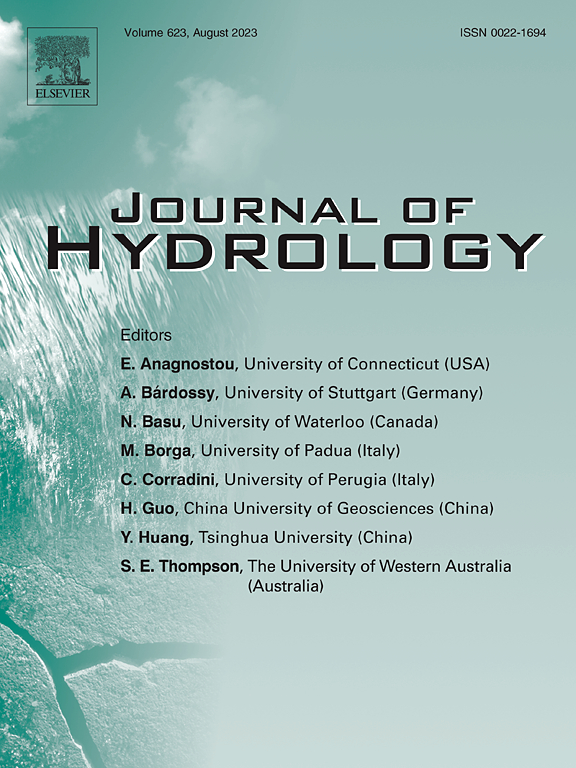Dynamic development of global contiguous flash droughts: from an event-based spatiotemporal perspective
IF 5.9
1区 地球科学
Q1 ENGINEERING, CIVIL
引用次数: 0
Abstract
Flash droughts can induce serious adverse effects on local ecology due to their rapid intensification. However, individual flash drought events have not been thoroughly analyzed to demonstrate their dynamic evolution and changes. Here we use a 3-D connectivity algorithm to identify large contiguous flash drought events globally from an event-based perspective, which allows for effective tracking of their full spatiotemporal development. Results show that during 1980–2020, 2322 large contiguous flash drought events occurred and mainly distributed globally in nine hotspots, with a strong seasonal preference for warm seasons. Flash drought events of longer lifetime and travel distance are more likely to occur at the high-latitudes. The intensity, duration, and frequency of these events increase statistically significantly, while their affected area and translation speed decrease. Although regional variations in propagation patterns exist, flash drought events tend to propagate more toward the northeast. Across much of the globe, the preceding meteorological conditions in over 50% of flash droughts are marked by the concurrence of elevated regional temperatures and precipitation deficits. The dominant role of individual drivers exhibits notable spatial heterogeneity, largely influenced by the latitude and regional weather systems. Precipitation deficits tend to be the primary driver in monsoon-affected regions, while elevated temperatures predominantly govern flash drought onset in the high-latitudes of the Eurasian continent. Precipitation deficits primarily (38.9%) determine the intensity of flash droughts, while high temperatures play a dominant role (42.2%) in the duration of flash droughts. Our results provide a new perspective for future projection of drought events.
全球连续突发性干旱的动态发展:基于事件的时空视角
突发性干旱因其迅速加剧,可对当地生态造成严重的不利影响。然而,对个别突发性干旱事件的分析还不够深入,不足以证明其动态演变和变化。在这里,我们使用三维连接算法从基于事件的角度识别全球大型连续突发性干旱事件,从而可以有效地跟踪其完整的时空发展。结果表明:1980—2020年,中国共发生2322次大型连续突发性干旱事件,主要分布在全球9个热点地区,具有较强的暖季偏好;高纬度地区更容易发生持续时间和传播距离较长的突发性干旱事件。这些事件的强度、持续时间和频率在统计上显著增加,而其影响范围和翻译速度则下降。虽然传播模式存在区域差异,但突发性干旱事件更倾向于向东北传播。在全球大部分地区,超过50%的突发性干旱之前的气象条件以区域温度升高和降水不足同时发生为特征。个体驱动因素的主导作用表现出显著的空间异质性,主要受纬度和区域天气系统的影响。在受季风影响的地区,降水不足往往是主要驱动因素,而在欧亚大陆高纬度地区,气温升高主要控制着突发性干旱的发生。降水亏缺主要决定突发性干旱的强度(38.9%),而高温对突发性干旱持续时间起主导作用(42.2%)。我们的研究结果为未来干旱事件的预测提供了新的视角。
本文章由计算机程序翻译,如有差异,请以英文原文为准。
求助全文
约1分钟内获得全文
求助全文
来源期刊

Journal of Hydrology
地学-地球科学综合
CiteScore
11.00
自引率
12.50%
发文量
1309
审稿时长
7.5 months
期刊介绍:
The Journal of Hydrology publishes original research papers and comprehensive reviews in all the subfields of the hydrological sciences including water based management and policy issues that impact on economics and society. These comprise, but are not limited to the physical, chemical, biogeochemical, stochastic and systems aspects of surface and groundwater hydrology, hydrometeorology and hydrogeology. Relevant topics incorporating the insights and methodologies of disciplines such as climatology, water resource systems, hydraulics, agrohydrology, geomorphology, soil science, instrumentation and remote sensing, civil and environmental engineering are included. Social science perspectives on hydrological problems such as resource and ecological economics, environmental sociology, psychology and behavioural science, management and policy analysis are also invited. Multi-and interdisciplinary analyses of hydrological problems are within scope. The science published in the Journal of Hydrology is relevant to catchment scales rather than exclusively to a local scale or site.
 求助内容:
求助内容: 应助结果提醒方式:
应助结果提醒方式:


